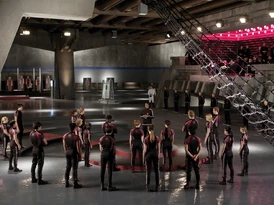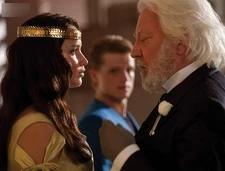- Peeta Mellark: "In the arena, you only get one wish. And it's very costly."
Caesar Flickerman: "It costs your life."
Peeta Mellark: "Oh, no. It costs a lot more than your life. To murder innocent people? It costs everything you are." - —Peeta Mellark and Caesar Flickerman on the Hunger Games[src]
The Hunger Games were a morbid and brutal competition which took place annually in the country of Panem, enacted upon the districts by the Capitol after their defeat in the First Rebellion. It was to serve as a punishment and a reminder to the defeated districts of the cost of insurrection and to never again make an attempt to rebel. They were held uninterrupted for seventy-five years.
Premise[]
Every year, one boy and one girl between the ages of 12 and 18 were selected from each of the twelve districts as tributes by a lottery. They would be taken to the Capitol, where there would be a week of festivities and training, and then they'd be sent into an arena to fight to the death. The event was nationally televised as mandatory viewing for all citizens, and the competition could last several days or weeks. The last living tribute was declared the victor, showered in gifts, and lived the rest of their life in luxury[1] and privilege in the Victors' Village. The winning district also received parcels of food from the Capitol for a year as reward for producing a victor.[2]
History[]
Inception[]
The Hunger Games were the creation of Casca Highbottom, but also indirectly by Crassus Snow and Dr. Volumnia Gaul. During Highbottom and Snow's final days at the University, she served as a professor there and assigned her class a final project: to create a punishment for one's enemies so extreme that they would never be allowed to forget how they had wronged them.[3]
Being best friends, Highbottom and Snow paired together for the project. Highbottom, having a mind for puzzles, began brainstorming the Hunger Games, something which Snow assured him was just a private joke between the two of them. Highbottom, however, was drunk and Snow continued to ply him with alcohol, playing on his vanity as he fleshed out the project. Snow then turned the project in to Dr. Gaul while Highbottom was sleeping off the alcohol, leaving Highbottom to awake horrified at what had happened and meaning to rip it to shreds. Gaul held on to the project and then, following the end of the war, pulled out the proposal and introduced Highbottom as the architect of the Games.[3]
Dr. Gaul saw the Games as a way to demonstrate how Panem would fall into anarchy without the Capitol to uphold order. She chose children to participate in order to prove that even the most innocent individuals could become lethal killers. Highbottom thought the idea would die out quickly, being so ghastly, but Dr. Gaul took it and ran.[3]
First Ten Years[]
The original Hunger Games were particularly brutal in their cruelty, with the event being seen as nothing more than a brutal punishment to the Districts. The tributes arrived to the Capitol in cattle cars, and upon arrival, they were held in stables that housed Peacekeepers' horses, and then thrown into the Capitol Arena the following day. They would be chained in the cattle cars to the point of before entering the arena. For the 10th Hunger Games, they were kept in the Capitol Zoo.[4] Here, they were underfed or even starved, and often mistreated by Peacekeepers. In the 10th Games, a number of tributes died before the Games began.
The first ten installments of the Games were held in the Capitol Arena, an old stadium converted into a fighting arena. Basic weapons were provided, but food and other supplies were not. Tributes were left in the arena to kill one another or starve until a lone victor remained. The winners of the first ten Games were not rewarded or given any special treatment; they simply returned to their home district and the life they formerly lived.[5]
The brutality of these early Games discouraged the general populace from watching unless they had an existing personal connection to one of the tributes. Capitol citizens even expressed doubt about the necessity of the Games, and whether it was viable to continue them. To counter this, the Gamemakers began to search for ways to make the Games more attractive, garnering public interest and approval. A number of changes— mentors, interviews, betting, and sponsorship— were implemented during the 10th Hunger Games. This marked the point where the Games evolved from being a simple brutal punishment to the districts, to a form of entertainment for the Capitol.
Final Years[]
In the 74th Hunger Games, Katniss Everdeen and Peeta Mellark of District 12 became the first and only joint victors after an attempted double suicide.[6] This inspired rebellion in the districts, and the unrest grew into uprisings. Eventually, a rebel plot interrupted the 75th Hunger Games, rendering it the first Games to end without the crowning of a victor, and marking the beginning of the Second Rebellion.[7]
The End of the Hunger Games[]
After the invasion of the Capitol and the overthrow of President Coriolanus Snow's regime, the interim government discussed a potential 76th Hunger Games using Capitol children. It was narrowly approved by the remaining Hunger Games victors,[8] but was never held due to the deaths of both interim President Alma Coin and deposed President Snow. Following an emergency presidential election, Commander Paylor ascended to the presidency,[9] the Hunger Games were abolished permanently, and the former arenas were demolished and replaced by memorials.[10]
Opening Ceremonies[]
The Opening Ceremonies last one week, starting with the reaping and ending with a night of interviews in the Capitol.
Reaping Ceremony (Day 1)[]

Effie Trinket, the District 12 escort, drawing a name from the Reaping Ball.
Every year, each district holds a lottery known as the reaping. On this day, the entire district population gathers at the Justice Building, where children of reaping age are sequestered into pens separated by age. Two large glass balls contain slips of paper with the names of each child through the ages of 12–18. The number of times a child's name is entered in the reaping bowl is cumulative and dependent on their age: a twelve-year-old has their name in once, a thirteen-year-old twice, and so on until the child is eighteen years old, where they will have seven slips in the bowl.
A reaping age child can choose to add their name more times in exchange for tesserae. Each tessera offers enough oil and grain to supply one family member with food for one year. A child can claim additional tesserae for as many family members as they choose, and entries are cumulative from year to year. For example, Katniss Everdeen took tesserae three times for herself, sister, and mother from ages 12-16, so she had 20 slips in the bowl at 16 for the 74th Hunger Games, while Gale Hawthorne, who claimed tesserae for five family members, had 42 slips in the bowl at 18.[1]
The district's escort has the duty of picking the name out of the bowls, one for girls and one for boys. The tributes whose names are chosen are then entered into the Hunger Games unless someone volunteers. Volunteering is normally rare in the outer districts because participation in the Hunger Games is viewed as a death sentence. As such, people there most often volunteer to spare someone from participating, such as when Katniss volunteered for her twelve-year-old sister, Primrose Everdeen.[11] However, the act of volunteering is far more common in the Career districts (1, 2, and 4 in the books, 1 and 2 in the films), where participation in the Hunger Games is seen as an act of honor and chance for glory. There, children spend years training in combat and survival before volunteering.[12]
Once a child passes their final reaping at the age of 18, they are no longer eligible for participation in the Hunger Games. Similarly, victors from previous Hunger Games are no longer eligible to be reaped or volunteer, even if they are still age-eligible.
Journey to the Capitol (Day 1-2)[]
Once the tributes are chosen, they are escorted into the Justice Building and brought into a room. The tributes are then allotted one hour to meet with family and friends to say goodbye and get their affairs in order. Once the hour is up, the tributes are escorted to a car that takes them to the train station, then they board a train bound for the Capitol.[13] The length of the train ride is likely dependent on the district; it took roughly a day for Katniss and Peeta to reach the Capitol by virtue of being from District 12, arguably the farthest district from the Capitol.[14]
During the train ride, the tributes typically make their first introductions to their mentor(s), a previous Hunger Games victor. Watching the reaping recaps is customary, usually as a means of gauging the competition. An extravagant banquet is served to the tributes upon arrival on the train, followed by a similarly exquisite dinner. Tributes have their own rooms with a built-in bath and full wardrobe. A number of amenities, such as the caboose, bar carriage, food, drink, and Avoxes, are at the tributes' disposal.[14]
Tribute Parade (Day 2)[]

The Tribute Parade along the Avenue of the Tributes for the 75th Hunger Games
Upon arrival in the Capitol, tributes are transported to the Remake Center, where they are introduced to their prep team. Over the next few hours, the prep team's responsibilities involve beautifying their respective tributes to the standards of the Capitol, after which they meet their stylist. The stylist, as head of the prep team, performs final touches on the tribute's makeover before presenting their vision for how they will be presented during the opening ceremonies. The tribute is then dressed in their costume, an extravagant outfit related to their district's industry, for the chariot ride in the evening.[15]
Once the tributes are prepared in their chariot costumes, they are led in a procession around the City Circle on horse-drawn chariots, starting with District 1. This event is the first time that many Capitol citizens see the tributes in person. As such, it is critical on the part of both the stylist and the tributes themselves to make a significant first impression in order to attract sponsors. It is also a chance for the tributes, wherever possible, to demonstrate what to expect from them in the coming days. The Tribute Parade concludes at the presidential mansion, where the President gives an opening address to the tributes and congratulates them on their courage. Then the chariots pull into the Training Center,[15] and the tributes are taken to their respective apartments.[16]
Training Sessions (Days 3-5)[]

Tributes of the 74th Hunger Games assemble for their training orientation.
The following day, tributes begin survival and combat training for the next three days. Training starts at 10am each day, and it is conducted in a massive gymnasium located in the basement of the Training Center. Here, the assembled tributes from each district are given an orientation by the Head Trainer, who gives them a run down on each of the survival and combat stations in the gym. Each station is manned by a number of experts in the field the station specializes in, ready to assist as needed for the tributes. During training, tributes are free to travel between the stations at their leisure and spend as much time as they desire at any one of the stations.[12]
Lunch is served in a cafeteria located in the gymnasium, and tributes return to their apartments for dinner at the end of each day of training. During training, tributes are free to socialize with and even train together with other tributes if they choose to do so, though they are not allowed to practice combat with one another. Training is also an opportunity for tributes to directly observe their competition, sizing up threats or forming alliances.[12]
Tributes are observed by the Gamemakers from an elevated balcony with a view of the entire gymnasium. After lunch on the third day of training, each of the tributes gets the opportunity to showcase their learned or pre-existing skills in a private session in front of the Gamemakers. They are called in one by one, starting with District 1 and alternating by sex (boy-girl-boy, etc).[12] Once their private session ends, the tributes return to their apartments where they await the announcement of their training score on television in the same order. Scores range from 1 to 12, with 12 being the highest. The impression they make in training and private sessions directly impacts how high of a score they receive, and goes on to affect how many sponsors they can draw in.[17]
Tribute Interviews (Days 6-7)[]

Caesar and Peeta during his interview in the 74th Hunger Games.
The final event before the start of the Hunger Games are the tribute interviews. Tributes spend the sixth day of the pre-Games with their mentor and escort, preparing for the following evening's interview with the host of the Hunger Games. The mentor advises their tribute on the best angle to go for based on their personality and demonstrated skills, and the escort drills the tribute on proper etiquette.[18]
On the seventh day, the last before the Games, the tributes once again meet with their prep team and stylist, who once again give their tribute a full makeover and dress them in an extravagant formal outfit fit for the stage.[18] In the evening, the tributes are brought to the stage in front of the Training Center, facing the audience arranged around the City Circle. One by one in district order, alternating by sex (girl-boy), they are brought out to the stage to meet the host. For the last thirty-five years of the Games, this was Caesar Flickerman.[18]
During the interview, Caesar asks each tribute about a number of topics: their life back home, their family, their impression of the Capitol, their training score, and so on. Each interview is fairly short and fast-paced, lasting only three minutes per tribute. How the tributes choose to approach the interview varies, but regardless of tactic, it's highly important that they stand out; this is their last opportunity to directly appeal to sponsors. Interviews also give the Capitol citizenry an opportunity to get to know the tributes on a personal level and pick their favorites.[18]
The Games[]
Pre-Launch[]
Following their interview, the tributes return to their apartments for the last time.[19] The following morning, the tributes are escorted by their respective stylist to a waiting hovercraft. It is here that each of the tributes are implanted with a tracker, a device that monitors their vital signs and position within the arena. Once all tributes are aboard, the hovercraft departs the Training Center for the arena. The length of time to get to the arena is dependent on its distance in relation to the Capitol.[19]
Once the tributes have arrived to the arena, they and their stylist are taken underground to the arena catacombs, arriving at the Launch Room. Here the tributes undergo their final dressing and preparations for the Games with their stylist. When the time comes, the tributes are directed to enter the launch tube, which seals them inside. A platform then raises the tributes upwards into the arena,[19] where a 60-second countdown commences. Prior to launch, tributes are advised not to step off their platform before the countdown ends, as doing so will activate a hidden mine under their pedestal, killing them instantly. Once the countdown completes, the Hunger Games officially commence.[20]
Cornucopia Bloodbath[]

The start of the 74th Hunger Games, just prior to the opening bloodbath
The opening act of any Hunger Games is the Cornucopia bloodbath, which kicks off the initial action. Tributes are launched in a circle equidistant from the Cornucopia. Inside the horn, sometimes scattered around it, are weapons. Other items available at the Cornucopia can (but do not necessarily always) include food, water, bags, tools, and other potentially vital supplies. The purpose of the Cornucopia is not only to aid the tributes in the arena, but to purposely draw them into a confrontation. As a result, many tributes end up dying here. In the 74th Hunger Games, 11 out of the 24 tributes died in the bloodbath— nearly half the playing field.[20]
The choice to make the run or not to the Cornucopia is one of the most critical initial decisions a tribute can make in the opening stages of the Games, due to the inherent high risk-high reward nature of the choice. Many tributes ultimately elect to venture into the opening scramble for a chance to get some of the plethora of valuable items scattered around, while others choose to outright flee into the arena to avoid the impending slaughter. Due to their statistical advantage as athletes, having been trained in combat for years, and being a part of a large preexisting alliance, the Career tributes inevitably end up dominating the other tributes in the opening battle and are usually responsible for the vast majority of the deaths in the bloodbath. As such, the bloodbath usually ends with the Careers in complete control of the Cornucopia and its cache of supplies, giving them a huge material advantage over tributes who fled with little or left empty-handed.[20]
Nightly Death Toll[]

Mags' fallen portrait displayed on the second night of the 75th Hunger Games.
Each evening in the arena, the anthem is played, and the tributes that died that day are displayed in the sky one by one in district order with their picture and district number to identify them. This helps the audiences and the surviving tributes in the arena determine who has died and the number of tributes that are still alive. On the televised broadcast only, audiences in the Capitol and districts are shown footage of each death; this is omitted inside the arena to maintain an element of uncertainty and strategy. In the books, these are displayed by cloaked hovercraft carrying huge screens,[20] while in the movies, they are projected against a sky-dome enclosing the arena.[21]
Feasts[]

The Cornucopia feast, with four backpacks in front on a table.
If food is scarce in the arena and the Gamemakers feel that there has not been enough bloodshed recently, they invite all of the tributes to the Cornucopia for a feast. The principle behind the feast is the same as that of the Cornucopia and the large number of supplies at the beginning of the Games: it is an inducement to fight. However, the Gamemakers have sometimes only offered a loaf of stale bread to fight over.[22] Attendance is not mandatory, but Gamemakers may try to tempt the tributes to attend by offering more than just food, as they did in the 74th Hunger Games.[23]
Closing Ceremonies[]
Remake[]
Once a tribute has been declared victor, they are immediately taken back to the Capitol for medical treatment. Any critical injuries sustained during their time in the arena are addressed mid-flight. Upon arriving at the Training Center, the new victor is transported to a dedicated medical facility in the sublevels of the building, below even the training gymnasium. A "full body polish" can remove scars sustained even before the victor entered the arena,[24] and the victors can be fitted with prosthetics[25] or even undergo cosmetic procedures without their consent.[24]
Victory Ceremony[]

Peeta and Katniss at their post-Games interview and recap.
Once a tribute has physically recovered, they are reunited with their team, including their mentor, stylist, and escort. Their prep team readies them for their next public appearance, and their stylist adds the finishing touches before fitting them into formal wear for the recap.
Later in the evening, the new victor is brought to the level of the Training Center where the gymnasium is, and the prep team, stylist, mentor, and victor rise up from beneath the stage in that order.[24] During the recap, the victor has to watch a three-hour edit of their Games, spanning from the opening ceremonies to the events of the Games themselves.[25]

Katniss is crowned victor of the 74th Hunger Games, shortly followed by Peeta.
At the end of the recap, the President crowns the latest victor with the victory crown. The victor and their entourage are then brought to the Victory Banquet, a lavish dinner held in honor of the victor at the President's mansion, where the victor greets Capitol officials and snaps photos with sponsors until dawn.
In the morning, the victor returns to the Training Center, and they get a few hours to rest before the prep team and stylist ready them for one last interview. During this interview, the Master of Ceremonies poses a slew of questions, typically focusing on the actions the victor made during the games, the reasoning behind some of the decisions they took, and how they responded to the challenges they faced in the arena, among others. The interview is fairly short, but much longer then the tribute interviews. Following this, the victor returns to their apartment, gathers their things and boards a train with their mentor back to their home district. Upon arrival in their district, the victor is typically celebrated and applauded by the district's populace for the victory in the Games and ability to return home. There, the victors remain for several months until the commencement of their Victory Tour,[25] "almost midway" between their Games and the next.[2]
Other aspects[]
Arena[]
Arenas are controlled environments where the annual Hunger Games are held. After each year's competition, these became tourist attractions where people could vacation and re-watch the Games, tour the catacombs, visit the sites of deaths, and take part in reenactments.[19] Once the Hunger Games were abolished, the arenas were all destroyed, and memorials were built instead.[10]
Mentoring[]
Mentors have the unique responsibility of guiding tributes through the Hunger Games and managing their sponsorships. This began with the 10th Hunger Games, where the mentors were the top twenty-four students at the Capitol's Academy;[26] however, previous victors of the Hunger Games would eventually take up the role.
Sponsorship[]

A sponsor gift.
Mentors, tributes, and stylists are responsible for attracting sponsors: district or Capitol citizens who provide monetary support to tributes. Sponsor gifts of food, water, medicine, or even weapons are delivered by silver parachutes inside the arena. This practice began in the 10th Hunger Games,[27] during which gifts were ordered by mentors and delivered by drone.[28] Gifts can get particularly expensive, requiring support from many sponsors in order to purchase.[29]
Muttations[]
Muttations (also known as mutts) are genetically modified creatures often unleashed inside arenas by the Gamemakers, who are responsible for designing and running each year's Hunger Games.
Tribute tokens[]
Each tribute is allowed to bring a token from their district to remind them of home.[13] Tokens must pass through a review board for approval, in order to ensure tributes are not bringing outside weapons.[19]
Quarter Quell[]
Every twenty-five years, the president of Panem selects a card— supposedly written at the Hunger Games' inception— outlining a change in the rules of the reaping for a special edition of the Hunger Games.[30]
List of Hunger Games[]
Trivia[]
- In an early draft of The Hunger Games film script, the events of the series are said to take place 300 years into the future.[31] Considering that the film was released in 2012,[21] this would mean that the trilogy begins around 2312. However, since none of this material was included in the final product, this is only speculatory.
- Throughout the history of the Hunger Games, there have been a total of 1,824 tributes that have participated in the seventy-five Hunger Games ever held. However, there were only 1,800 unique tributes due to nature of the Third Quarter Quell. On the eve of the 75th Hunger Games, there were 59 living victors out of the 75 in total that won. By the end of the Second Rebellion, of 1,800 individuals reaped, 1,725 died in the Hunger Games they participated in, while 68 more tributes, all victors, died either due to various causes including natural death (16), during the 75th Hunger Games as participants that died (18), or during the Victors' Purge that occurred during the Second Rebellion or in battle during the Second Rebellion (34). Thus, only 7 remaining victors.
- In Mockingjay, when Katniss asks what the day is during an outing, she learns it's a week until September. She then states, "That means Snow has had Peeta in his clutches for five, maybe six weeks." From this, it can be concluded that, since Peeta was captured at the end of the 75th Hunger Games, the Games start in middle to late July. This is further affirmed in The Ballad of Songbirds and Snakes, which states the reaping is held on July 4th, a date implied to be annual. Thus it can be inferred the typical start date of a Hunger Games is on July 11th, a week later.
- The Hunger Games were inspired by the myth of Theseus and the sacrificial victims of Minotaur,[32] as well as Roman gladiatorial combat.[33]
References[]
- ↑ 1.0 1.1 The Hunger Games, Chapter 1
- ↑ 2.0 2.1 Catching Fire, Chapter 1
- ↑ 3.0 3.1 3.2 The Ballad of Songbirds and Snakes, Epilogue
- ↑ The Ballad of Songbirds and Snakes, Chapter 3
- ↑ The Ballad of Songbirds and Snakes, Chapter 9
- ↑ The Hunger Games, Chapter 25
- ↑ Catching Fire, Chapter 27
- ↑ Mockingjay, Chapter 26
- ↑ Mockingjay, Chapter 27
- ↑ 10.0 10.1 Mockingjay, Epilogue
- ↑ The Hunger Games, Chapter 2
- ↑ 12.0 12.1 12.2 12.3 The Hunger Games, Chapter 7
- ↑ 13.0 13.1 The Hunger Games, Chapter 3
- ↑ 14.0 14.1 The Hunger Games, Chapter 4
- ↑ 15.0 15.1 The Hunger Games, Chapter 5
- ↑ The Hunger Games, Chapter 6
- ↑ The Hunger Games, Chapter 8
- ↑ 18.0 18.1 18.2 18.3 The Hunger Games, Chapter 9
- ↑ 19.0 19.1 19.2 19.3 19.4 The Hunger Games, Chapter 10
- ↑ 20.0 20.1 20.2 20.3 The Hunger Games, Chapter 11
- ↑ 21.0 21.1 The Hunger Games (film)
- ↑ The Hunger Games, Chapter 18
- ↑ The Hunger Games, Chapter 20
- ↑ 24.0 24.1 24.2 The Hunger Games, Chapter 26
- ↑ 25.0 25.1 25.2 The Hunger Games, Chapter 27
- ↑ The Ballad of Songbirds and Snakes, Chapter 1
- ↑ The Ballad of Songbirds and Snakes, Chapter 6
- ↑ The Ballad of Songbirds and Snakes, Chapter 13
- ↑ The Hunger Games, Chapter 14
- ↑ Catching Fire, Chapter 3
- ↑ https://www.screenwritersnetwork.org/wp-content/uploads/2021/02/The-Hunger-Games-1-Script.pdf
- ↑ https://www.publishersweekly.com/pw/print/20080609/9915-a-dark-horse-breaks-out.html
- ↑ https://www.slj.com/story/a-killer-story-an-interview-with-suzanne-collins-author-of-the-hunger-games
